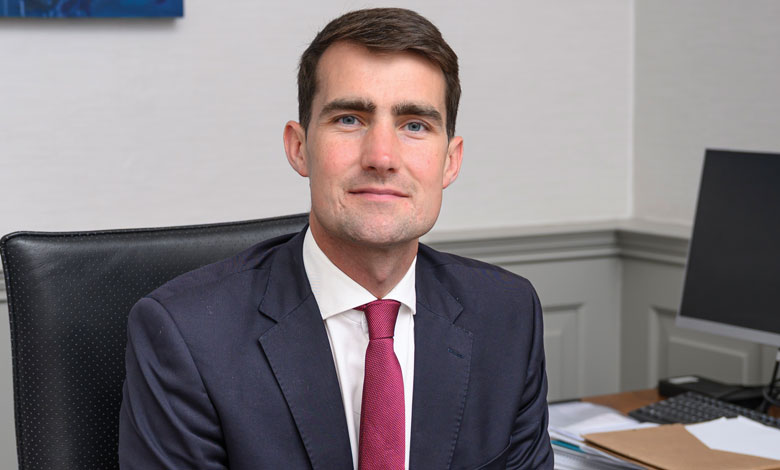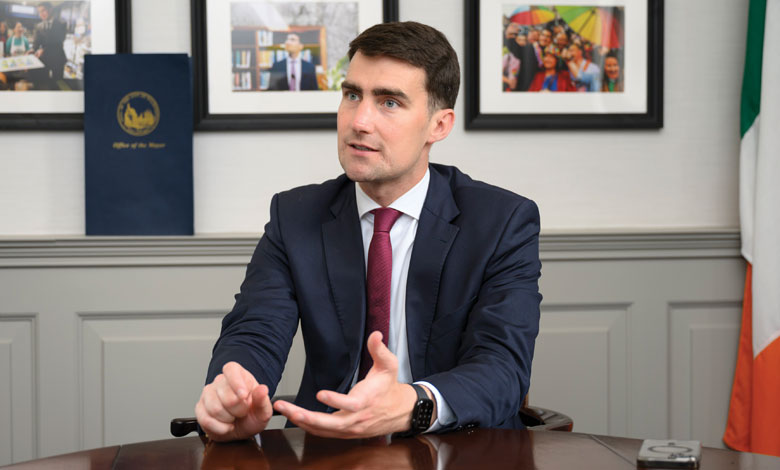Minister Jack Chambers TD: ‘We will shorten the infrastructure project lifecycle’

Minister for Public Expenditure, Infrastructure, Public Service Reform and Digitalisation, Jack Chambers TD, speaks to Ciarán Galway about the Government’s updated National Development Plan (NDP), unpacks the Summer Economic Statement 2025, and discusses Ireland’s exposure to the evolving global trade landscape.
Chambers is a risen star among the coalition government’s Fianna Fáil cohort. Within a week in June 2024, then aged 33, he became his party’s deputy leader and the Finance Minister in the previous government. Having guided Fianna Fáil through general election 2024 – as director of elections – he was appointed to his current portfolio on 23 January 2025.
Sitting in an immaculate Government Buildings office a little over six months later, the Minister is unsurprisingly keen to emphasise his commitment to enhanced capital expenditure.
With no fewer than 75 mentions in Programme for Government 2025, enhanced infrastructure delivery is a major focus of the current administration, given its role as a key driver of FDI, economic growth, housing delivery, and climate action.
“We have come from a period of historic low [capital] investment to one with higher investment with slower delivery systems. So, a strategic priority for me is to accelerate and reposition delivery systems in light of record levels of capital funding. That is to unblock a lot of the challenges that we have around basic infrastructure in our country. With the new infrastructure brief and Infrastructure Division in this department, there is a real strategic priority, and a lot of policy reform will come from that,” the Minister observes.
A second strategic priority identified by Chambers is managing the macroeconomic and fiscal position of the State to ensure “spending efficiency with discal stability”.
“We have a lot of work ongoing on reviewing public financial procedures, enhancing value for money considerations in the budget process, and really driving reform to give more headroom to ministers in the budget decisions that they make in terms of their baseline position,” he says.
“Central to all that is to make sure the decisions we make are affordable and sustainable and that informs the decisions we will make in Budget 2026.”
Updated NDP
In October 2024, Ifac published its Ireland’s Infrastructure Demands in which it determined that “Ireland’s infrastructure is now 25 per cent lower than average for a high-income European country”.
Subsequently, in late July 2025, the Government published its updated NDP, or capital investment plan, “with unprecedented levels of investment” totalling €275.4 billion from 2026 to 2035, including sectoral capital allocations of €102.4 billion for 2026 to 2030.
Asked how the updated NDP compares with its previous two iterations – 2018 and 2021 – the Minister insists that “it is very clear in its strategic prioritisation” rather than “just setting out allocations across departments”. He adds that this makes “a kind of strategic different distinction between this NDP and others”.
“We are going to drive high impactful reforms in the autumn on trying to remove the barriers and truncate and shorten the project lifecycle.”
Minister for Public Expenditure, Infrastructure, Public Service Reform and Digitalisation Jack Chambers TD
At just 49 pages, the 2025 NDP is much reduced in volume when compared with 2018 (109 pages) and in 2021 (184 pages). Its scant content also markedly contrasts with the previous two iterations in that it eschews detail in relation to specific projects.
“We want departments and agencies to develop sectoral investment plans, which is a different approach to previous years, where we had long lists of projects,” the Minister acknowledges.
“We want to develop sectoral investment plans, again learning from the barriers to infrastructure delivery which have been documented to us by stakeholders; that there is not real clarity or certainty on what a list means.”
As such, work is ongoing to transpose the funding envelopes given to each department into investment plans, “which has sectoral certainty to build a project pipeline”. These are anticipated to be published in autumn 2025.
Accelerated delivery
To date, the NDP has been beset with project delivery delays. Almost 13 per cent (11 projects) of the 88 large projects earmarked for delivery between 2020 and 2025, will not be completed on time.
In this context, the Minister believes that ongoing work to address barriers to effective infrastructure delivery within the State is “as important a piece of work as the additionality in the NDP”.
“The funding announced last week [22 July 2025] provides a huge uplift in the overall allocation – in excess of €30 billion compared to the baseline position over the next five years. But really, what is more important is making the case for reform,” he says.
However, rather than a funding challenge, Chambers characterises the “most impactful barriers to the timely development of infrastructure” as being challenges relating to processes and systems. In response, he believes in a “redesign” of delivery systems “to drive and accelerate infrastructure in the economy”.
Following the public engagement and stakeholder engagement on barriers to delivery, which concluded with the Minister publishing Accelerating Infrastructure – a report on accelerating the development of infrastructure and the “most impactful barriers” impeding this development – on the day of this interview.
“We now have the first evidence-based report which sets this out across 12 thematic areas, and we are going to drive high impactful reforms in the autumn on trying to remove the barriers and truncate and shorten the project lifecycle.”
Ambition
Asked to summarise the Government’s ambition for the State’s stock of public infrastructure by the end of this decade, Chambers initially focuses on megaprojects.
“They have been sitting waiting to get the go-ahead, some of them over 10 years, some of them over 20 years, and actually seeing them advancing and commenced would be an important milestone.”
Secondly, the Minister reiterates the importance of housing delivery and the critical infrastructure to enable that. “The public sense of infrastructure delivery is that it is slow, cumbersome, fragmented, and endless in process. If in three to five years, we see infrastructure defined by momentum, a pipeline of projects, and tangible commencements, that will switch the sense of infrastructure delivery. That is a real metric.
“Once projects are published in terms of sector investment plans, that will give a medium-term position on what is possible. We have a lot of projects now that are emerging from planning. Getting them commenced will show that there is delivery happening on the ground.”
Macroeconomic assessment
Asked to unpack his assessment of the Irish economy, the Minister remains upbeat amid the swirling uncertainty in the global trade policy landscape. Describing the current position as “a real point of economic strength”, he points to the figure of 2.8 million people working across the State – 400,000 more than before the Covid pandemic.
“When you think of the series of crises that we have navigated through – with one million people out of work [at the height of the pandemic], the inflationary crisis, and the cost-of-living crisis – we have shown phenomenal economic resilience over the last five years.
“We are building up our fiscal buffers with the two reserve funds – the Future Ireland Fund and the Infrastructure Climate and Nature Fund – and that allows us the ability to navigate the challenges of tomorrow in a careful, considered, and sustainable way.”
On the macroeconomic challenges, Chambers stresses that government has not been surprised by the challenge of deglobalisation, which he says, “did not arrive with President Trump”.
Outlining government’s response, the Minister asserts that market diversification, consolidating domestic economic competitiveness, and regulatory simplification will be key.
Referencing the opportunities of a changing geopolitical environment and a continued demand for enhanced trade and cooperation across the world, the Minister asserts that “Ireland needs to be at the forefront of those conversations”.
Exposure
Given the prevailing volatility in global trade policy landscape, Ireland is exposed. In the joint foreword to Summer Economic Statement 2025, Chambers and his cabinet colleague, Minister for Finance Paschal Donohoe TD, acknowledge this: “There is now concrete evidence that the transatlantic economic relationship has taken a step backwards.”
Elaborating, the Minister admits: “Look, we are an open trading economy which tries to provide efficiencies and value added to a global supply chain. With uncertainty and security of supply sometimes superseding efficiency of supply, given how geopolitics have evolved – and economic nationalism being the thematic development in recent times – that presents a risk for the Irish economic model.”
Summer Economic Statement 2025 was published with an applied assumption of no change against a 10 per cent baseline tariff in place since April 2025. Five days later, however, the US-EU trade deal established a baseline 15 per cent tariff for most exports from the EU to the US.
“Ultimately, we now have an EU-US trade agreement that provides predictable investment proposition for indigenous and foreign direct investors into Ireland, many of whom still need to trade within Europe and elsewhere. So, while the tariff environment is more challenging than what preceded it, we are still looking to diversify markets, and the EU is examining other international markets,” Chambers remarks.
“We know that there is a ceiling of 15 per cent. The European Commission has said that it wants to continue to build a proposition which has enhanced ‘zero for zero’ cooperation across measures. We know that aviation is now at that, so are certain agrifoods and certain generic drugs. Hopefully, in time, as the new trading relationship settles, there will be further opportunities to lower that [tariff figure] for particular sectors and Ireland will benefit from that.”
Current expenditure
In the first six months of 2025, current expenditure is growing at a pace exceeding budget 2025 forecasts. As per the June 2025 fiscal monitor, current spending was €45.1 billion at end-June 2025, or 6.5 per cent (€2.8 billion) ahead of where it was in the first six months of 2024 – and well ahead of the 1.4 per cent growth outlined in Budget 2025.
Once again, as highlighted by Ifac, spending overruns in 2024 were not factored into budgeting for 2025. Consequently, spending overruns in 2025 are expected to total at least €2 billion.
While Ifac outlines that “the first five months show spending overruns in many different areas”, however, to date, monthly profiles of departmental expenditure have not been published in 2025. In fact, in its June 2025 Fiscal Assessment Report, Ifac reported that having requested these monthly profiles, the Department of Public Expenditure Infrastructure Public Service Reform and Digitalisation had failed to provide them.
“They [corporation tax receipts] are exceptional because of our industrial and enterprise policy, which we need to protect and nurture in the context of changing geopolitics.”
Disputing that ‘many’ departments are exceeding their spending projections for 2025, the Minister confirms that 10 of the 18 government departments remain within current spending parameters.
“If you look back over the last five years, we have had an average growth in expenditure of about 9 per cent. What has accelerated that has been the in-year decisions or issues that emerged during the year, which contributed to the overall growth in public expenditure. This year, it is at about 6.5 per cent presently, compared to last year, and the overall growth of public expenditure is actually connected to the increase in capital expenditure, which is what we want to see,” the Minister claims.
Conceding that “we do need enhanced fiscal discipline”, he outlines that the work being undertaken for Budget 2026 has three focuses: adequacy, efficiency, and fiscal sustainability.
“That means, in the estimates process prior to 2026, ensuring that the best mitigation [from] in-year decisions which contribute to overruns in terms of current expenditure, and we need to try to prevent that more next year compared to the last five years, particularly when we agree a medium-term expenditure framework and medium-term fiscal framework under the EU rules. Enhanced fiscal discipline between the budgets will have to be improved next year.”
Exceptional corporation tax receipts
However, this begs the question: Where would the public finances be in the absence of exceptional corporation tax receipts?
“They [corporation tax receipts] are exceptional because of our industrial and enterprise policy, which we need to protect and nurture in the context of changing geopolitics,” Chambers responds.
In the Fiscal Assessment Report: Ireland’s Bounty, published in December 2024, Ifac outlines that in the absence of exceptional corporation tax receipts, government would be running a deficit of €6.3 billion in 2024. “In effect, the surplus is being produced by a handful of foreign multinationals based on their worldwide profits,” it added.
In July 2025, Ifac chair, Seamus Coffey reiterated this point when he appeared before the Oireachtas Select Committee on Budgetary Oversight, stating: “After accounting for exceptional corporation tax and a strong economy, the government is running a substantial deficit.”
One week later, the Central Bank of Ireland’s Deputy Governor, Vasileios Madouro, warned the committee that rapid economic growth and exceptional corporate tax receipts “could be at risk in the coming years”.
In the meantime, the Fiscal Monitor for July 2025 once again recorded corporation tax revenue (excluding CJEU revenues) was €1.8 billion or 14 per cent ahead of the same period in 2024.
However, as well as highlighting the importance of tax competitiveness – “we have our position within the European Union” – the DPER Minister emphasises the significance of Ireland’s “exceptional” talent for foreign direct investors and indigenous businesses alike, and its stable business and political environment.
“The fact that we have a stable, predictable industrial policy still makes Ireland an attractive place to do business. The fact that we are very focused, as a government, on competitiveness as an issue and the decisions that we will have to make from that will yield opportunities for our country,” he says.
Budget 2026
Asked to define the expenditure strategy within Budget 2026, the Minister notes that it is currently under development. Opaquely, he replies that the budget will deliver “targeted interventions across different departments”, particularly in terms of social protection, child poverty, and driving the competitiveness agenda.
“Obviously, the investment in infrastructure will form a core part of Budget 2026,” he adds, while indicating that future proofing public services in response to changing demographics will also be a key feature.
“We will not be doing one-off measures,” he insists. “Whatever measures we take need to be targeted. They need to be within the fiscal parameters, and they need to be sustainable for the medium to long term.
“We have agreed a Summer Economic Statement and a budget package which still allows for progress across key policy areas and will help families, will help improve living standards and public services.”
This means, he explains, that ministers will be expected to make choices around their priorities, rather than “sitting one-off measures above permanent measures which have been taken”.
Given the economy’s strong performance, Ifac suggests that support from budgetary policy is not required. Recent budgets, it argues, have “pumped money into an economy that is already performing well” or, in other words, have been procyclical.
When this is put to the Minister, he responds directly: “We want to moderate.”
Vision
Outlining his vision for the lifetime of the Government, the Minister specifies that his “number one priority” is “enabling and driving infrastructure reform” to unlock the delivery of tens-of-thousands of new homes.
“We have an important role in the Department of Public Expenditure to drive and make the case for reform within the Irish economy,” he says.
Describing infrastructure delivery and reform as one of the major challenges facing the State, and acknowledging the criticisms associated with the existing deficit, Chambers concludes: “I want to switch that; to build momentum and confidence and positivity on that as we enter the 2030s.
“Similarly, it [the vision] is – as part of the budget process – to fulfil a lot of the commitments in the Programme for Government on in terms of improved public services and living standards, ensuring that we enter the next phase in the 2030s in an economy which is resilient, more diversified, and is embracing new opportunities, particularly around the digital transition and digitalising public services, while trying to build a low carbon future. All of that connects back to infrastructure delivery.”






